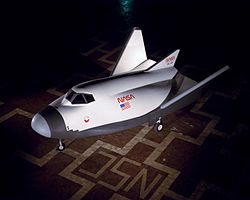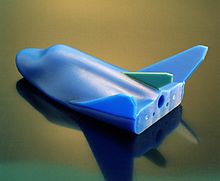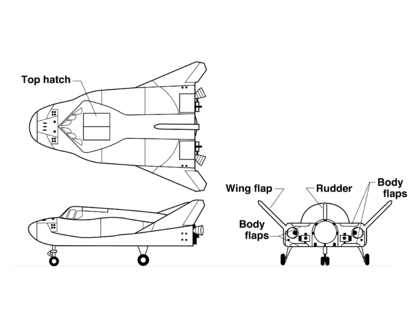- HL-20 Personnel Launch System
-
HL-20 Personnel Launch System 
HL-20 Mock-UpOperator NASA Mission type Orbiter Satellite of Earth Mass 10,884 kg The HL-20 Personnel Launch System was a circa 1990 NASA spaceplane concept for manned orbital missions studied by NASA's Langley Research Center in Hampton, Virginia. HL-20 was envisaged as a lifting body re-entry vehicle based on the Soviet BOR-4 spaceplane design featuring low operational costs, improved flight safety, and a possibility of landing on conventional runways.[1] No flight hardware was ever built.
Contents
PLS concept
With increasing national interest in obtaining routine access to space, a number of Earth-to-orbit transportation systems were being studied in the mid-1980s. One, referred to as a Personnel Launch System (PLS), could utilize the HL-20 and an expendable launch system to provide manned access complementing the Space Shuttle. A full-size engineering research model of the HL-20 was constructed in 1990 by the students and faculty of North Carolina State University and North Carolina A & T University for studying crew seating arrangements, habitability, equipment layout and crew ingress and egress. This engineering research model is 29 feet (9 m) long and provided the full-scale external and internal definition of the HL-20 for studies at the Langley Research Center.
The PLS mission is to transport people and small amounts of cargo to and from low-Earth orbit, i.e., a small space taxi system. Although never approved for development, the PLS concept spaceplane was designed as a complement to the Space Shuttle and was being considered an addition to the manned launch capability of the United States for three main reasons:[2]
- Assured manned access to space. In the era of Space Station Freedom and subsequent missions of the Space Exploration Initiative, it is imperative that the United States have an alternate means of getting people and valuable small cargo to low-Earth orbit and back should the Space Shuttle be unavailable.
- Enhanced crew safety. Unlike the Space Shuttle, the PLS would not have main propulsion engines or large payload bay. By removing large payload-carrying requirements from personnel delivery missions, the PLS would be a small, compact vehicle. It is then more feasible to design an abort capability to safely recover the crew during critical phases of the launch and return from orbit.
- Affordable costs. As a small vehicle designed with available technologies, the PLS is forecast to have a low development cost. Subsystem simplification and an aircraft approach to PLS ground and flight operations can also greatly lower the costs of operating PLS.
Two designs being considered[when?] for PLS differ in their aerodynamic characteristics and mission capabilities. While a Johnson Space Center's approach uses a blunt cone shape with a parachute landing system,[clarification needed] the Langley Research Center's design is a lifting body that can make a conventional runway landing on return from orbit.[2]
Lifting body development
Predating and influencing the design of the Space Shuttle, several lifting body craft including M2-F2, M2-F3, HL-10, X-24A, and X-24B were flown by test pilots during the period 1966-1975. The M2-F2 and the HL-10 were proposed in the 1960s to carry 12 people to a space station following launch on a Saturn IB. The HL-20 PLS concept has evolved from these early shapes and based on the Russian versions Kosmos-1445 and Kosmos-1374 and later MiG-105. The "HL" designation stands for horizontal lander, and "20" reflects Langley's long-term involvement with the lifting body concept, which included the Northrup HL-10.
A lifting-body spacecraft, such as the HL-20, would have several advantages over other shapes. With higher lift characteristics during flight through the atmosphere while returning from orbit, the spacecraft can reach more land area, and the number of available landing opportunities to specific sites would be increased. G-forces loads during entry would be limited to about 1.5 G. This is important when returning sick, injured, or deconditioned Space Station crew members to Earth. Wheeled runway landings would be possible, permitting simple, precision recovery at many sites around the world, including the Kennedy Space Center launch site.[2][Full citation needed]
Proposed missions
Originally, delivery of passengers to Space Station Freedom would have been the primary mission of a PLS. For the baseline space station mission, depending on design the crew size would be either eight or ten crew members.[3][Full citation needed]
A typical PLS mission operation scenario, using an HL-20, would commence at the Kennedy Space Center with the HL-20 being processed horizontally in a vehicle processing facility while an expendable launch vehicle is processed vertically in a separate facility. The launch vehicle and HL-20 would be mated at the launch pad and the launch sequence initiated as the space station passes over the launch site.
Following launch, the HL-20 would initially enter a low 100-nautical-mile (200 km) orbit to chase after the space station and then transfer up to the space station orbit altitude of 220 nautical miles (410 km). After rendezvous and docking at Space Station Freedom, crews would be exchanged, followed by an HL-20 return to Earth at the earliest opportunity.
The HL-20 would land horizontally on a runway in manner similar to the Space Shuttle. Total mission duration would not exceed 72 hours.[2]
Other potential missions defined for a PLS included the orbital rescue of stranded astronauts, priority delivery and observation missions, and missions to perform satellite servicing. For these other missions, the basic HL-20 design would be unchanged, but interior subsystems and arrangements would be modified according to crew accommodations, duration, and equipment required for the particular mission.[2]
Design features
The HL-20 concept of the PLS is adaptable to several launch vehicle concepts. Titan III was an existing booster system which could have been used for unmanned prototype launches or would require modification to be used as a manned system. A future launch system option would have been the National Launch System under study by the Air Force and NASA in the 90's. Choice of a launch system for the HL-20 PLS would depend both on the required date of initial PLS operations and the cost of booster development and launches.
The design philosophy of the HL-20 PLS concept was to complement the Space Shuttle with safe, reliable manned transportation at the lowest cost.[2] Crew safety was of utmost importance with emphasis being given in the HL-20 design to launch abort situations and the protection of the crew during vehicle recovery.[2] Other requirements had focused on minimizing life-cycle costs of the system by insuring simple operations, low-cost manufacturing, and high utilization potential.[2] When not including the time of the mission, turnaround time was expected to be 43 days.[3]
With an overall length of about 29 feet (9 m) and span across the wingtips of 23.5 feet (7.2 m),the HL-20 PLS concept would be a much smaller craft than the Space Shuttle Orbiter. In fact, the HL-20 could fit within the payload bay of the Shuttle with wings folded. Overall, the HL-20 would weigh 22,000 pounds (10,000 kg) without crew compared to the Space Shuttle Orbiter's empty weight of 185,000 pounds (84,000 kg). The space available inside for the crew and passengers, although less than the Shuttle, would be more than found in today's small corporate business jets.
A very important aspect of the HL-20 PLS concept which would help insure low cost operations is its design for maintainability. Large exterior access panels permit technicians easy access to subsystems which would be exposed and easily replaced if required. The vehicle would be processed in a horizontal position. Selection and design of subsystems would emphasize simplicity and reduce maintenance requirements. For example, hydraulic systems would be replaced by all-electric controls. Unlike the Space Shuttle, the HL-20 would not have a payload bay or main engine propulsion, thereby reducing the processing time. The thermal protection system would be similar to the Space Shuttle's, but the much smaller size of the HL-20 would result in major reductions in inspection and maintenance times. These design changes and subsystem simplifications, along with the adoption of aircraft maintenance philosophies, could reduce the HL-20 processing manhours to less than 10 percent of those currently used for the Space Shuttle Orbiter.
The design of the HL-20 PLS concept has taken into account crew safety and survivability for various abort modes. The interior layout with a ladder and hatch arrangement has been designed to permit rapid egress of passengers and crew for emergencies on the launch pad. For on-the-pad emergencies or during launch where time is a critical element (launch vehicle fire or explosion), the HL-20 would be equipped with emergency escape rockets which can rapidly thrust the PLS away from the booster. The method is similar to that used during the Apollo program. Once at a safe distance, a cluster of three emergency parachutes would open to lower the vehicle to a safe ocean landing. Inflatable flotation devices ensure that it rides high in the water, with at least one of two hatches available for crew emergency egress.
Contracted efforts
In October 1989, Rockwell International (Space Systems Division) began a year-long contracted effort managed by Langley Research Center to perform an in-depth study of PLS design and operations with the HL-20 concept as a baseline for the study. Using a concurrent engineering approach, Rockwell factored supportable, efficient design and operations measures into defining a detailed, cost-effective design along with a manufacturing plan and operations assessment. A key finding of this study was the realization that while design and technological factors could reduce costs of a new manned space transportation system, further significant savings would be possible only if a new operations philosophy were adopted which treated PLS in a manner similar to an operational airliner rather than a research and development space vehicle.
In October 1991, the Lockheed Advanced Development Company began a study to determine the feasibility of developing a prototype and operational system. The study objectives were to assess technical attributes, to determine flight qualification requirements, and to develop cost and schedule estimates.
A cooperative agreement between NASA, North Carolina State University and North Carolina A&T University led to the construction of a full-scale model of the HL-20 PLS for further human factors research on this concept. Students at the universities, with requirements furnished by Langley and guidance from university instructors, designed the research model during their spring 1990 semester with construction following during the summer. The human factors research objectives, using this model, were to assess crew ingress and egress operations, assess crew volume and habitability arrangements, and determine visibility requirements for the crew during critical docking and landing operations.
The testing, using Langley Research Center volunteers as subjects, was completed on the HL-20 model in December 1991. Langley volunteers, wearing non-pressurized flight suits and helmets, were put through a series of tests with the craft placed in both horizontal and vertical modes.
The horizontal study found, for example, that a 10-member crew has adequate volume to quickly and orderly get in and out of the spacecraft; the available volume and proximity to others was more than reasonably acceptable for a 10-member crew; more side-head room was desirable for the last row of seats to accommodate someone taller than 5 feet 7 inches (1.70 m); a wider aisle, removable seats and more training could improve emergency personnel capabilities and performance; more downward viewing capability for the pilot was desirable. The cockpit display and seat design needed to be integrated with window placement.[2]
Testing the HL-20 in a vertical position as oriented for launch posed a new set of factors. Getting in and out of the spacecraft, for example, required climbing through a hatch and up or down a ladder. In the horizontal mode, crew members walked along an aisle leading through the tail, which would be the exit-entry path at a space station or on the ground after a runway landing.
Partial-pressure suits, borrowed from the Johnson Space Center in Houston, were used for part of the study. Participants noticed less head room and restricted movement with the bulkier and heavier suits.
The results of the human factors studies showed where improvements in the baseline HL-20 design were desirable. The improvements would have little impact on overall vehicle shape or aerodynamic performance.
Legacy
The Dream Chaser spacecraft is based on the HL-20 lifting body design. It was developed by SpaceDev for the 2004 Commercial Orbital Transportation Services competition, and is now being developed by Sierra Nevada Corporation for the Commercial Crew Development program (CCDev).
Orbital Sciences Corporation has also proposed an HL-20 derivative for the second round of CCDev funding, the Prometheus spacecraft.
Both vehicles are proposed to launch unfaired atop a man-rated Atlas V launch vehicle.
See also
- NASA X-38
- Dream Chaser
- Prometheus
References
- ^ Chang, Kenneth (January 31, 2011). "Businesses Take Flight, With Help From NASA". NYTimes.com. Boulder, Colorado: The New York Times. http://www.nytimes.com/2011/02/01/science/space/01private.html?_r=1. Retrieved June 25, 2011.
- ^ a b c d e f g h i NASA.gov HL-20 model for Personnel Launch System research
- ^ a b X-15/HL-20 Operations Support Comparison
External links
- NASA.gov HL-20 model for Personnel Launch System research
- HL-20 Personnel Launch System video
- HL-10 and HL-20 video
- Astronautix.com's HL-20 web page
- Aerodynamic Characteristics of HL-20
- X-15/HL-20 Operations Support Comparison
- Improving the Subsonic Performance of Proposed Personnel Launch System Concept
- Design and Fabricatio of the NASA HL-20 Support Cradle and Interior Mockup
- Launch-Pad Abort Capabilities of the HL-20 Lifting Body
- Design and Fabrication of the NASA HL-20 Full Scale Research Model
Categories:- Lifting body aircraft
- Manned spacecraft
- NASA programs
- Rocket-powered aircraft
Wikimedia Foundation. 2010.





